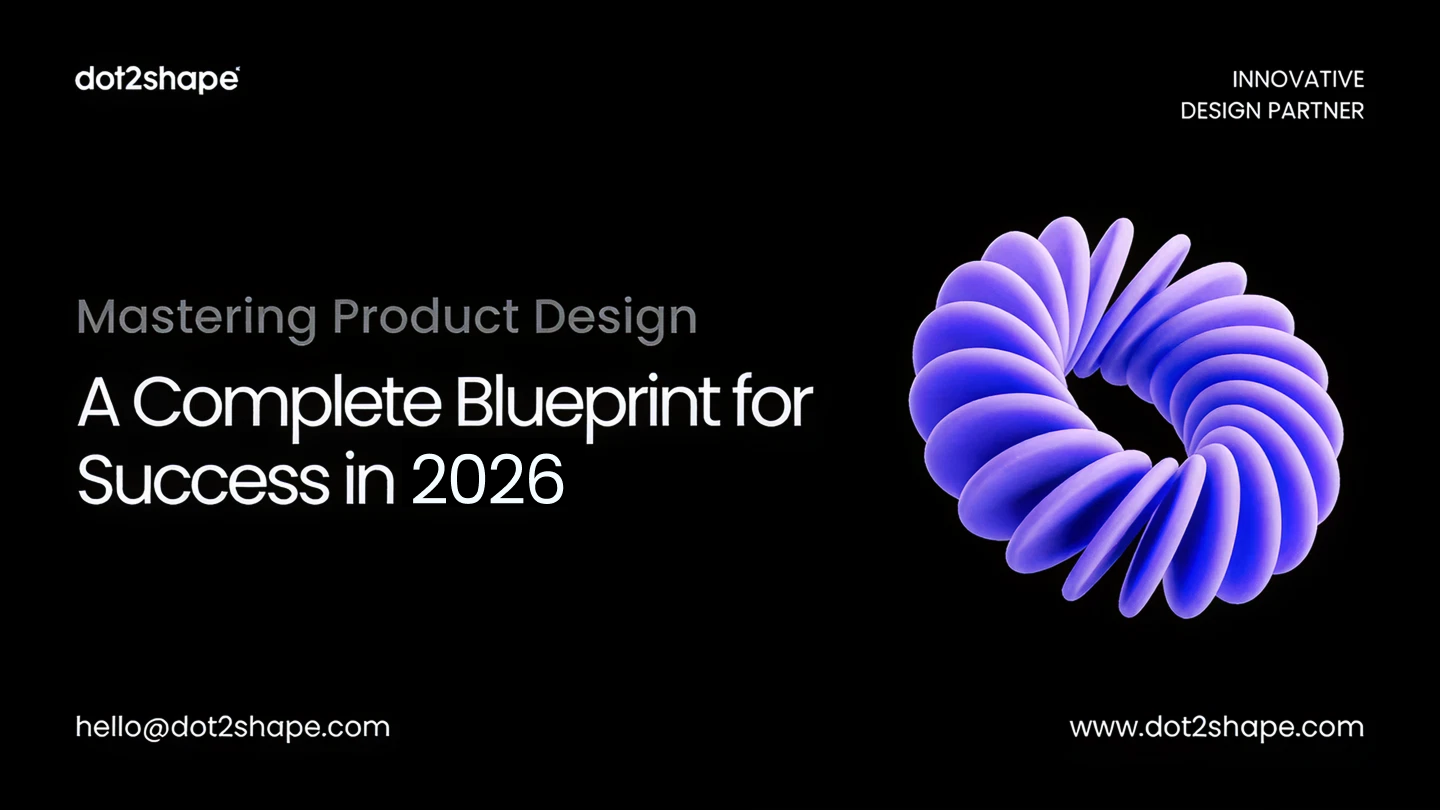Product Design: The Art and Science of Creating User-Centered Solutions
Mastering Product Design is about creating flawless, intuitive, user-centric experiences—not just aesthetics. Whether you’re a startup refining your brand identity, an entrepreneur launching your first digital product, or a designer seeking inspiration, understanding the product design process is essential for business success.
Consider your favorite mobile app or software. What makes it exceptional? It combines thoughtful design thinking, ease of use, and functionality. How can product designers ensure their creations truly resonate with users? Let’s explore the ten essential steps that lead to exceptional product design.
1. The Power of Ideation and Brainstorming Process
Every outstanding product begins with an idea but not just any idea, the right one. Brainstorming is where strategy meets creativity. Product teams, designers, and stakeholders collaborate to identify problems, generate multiple solutions, and filter the best concepts for further development.
Teams designing a new mobile application might brainstorm various features based on what makes the app enjoyable and user-friendly. This stage sets the foundation for effective product development and provides the groundwork for innovation.
Key benefits of effective ideation:
- Generates multiple creative solutions
- Identifies market opportunities
- Aligns team vision and goals
- Reduces development risks
2. Establishing a Clear Product Vision
Once ideas emerge, a clear product vision must be established. A well-defined vision ensures every design decision supports the product goals. This stage involves answering critical questions:
- What problem does this product solve?
- Who is the target audience?
- How will it differentiate in the market?
- What’s the value proposition?
Designers who establish a strategic direction create products that not only look appealing but also deliver real user value and business results.
3. Understanding User Needs Through User Research
Great design starts with empathy. Understanding user needs requires comprehensive research, including market analysis, competitive research, and direct user feedback.
For example, when designing an e-commerce platform, understanding user behavior—how they navigate sites and what frustrates them—helps create a seamless shopping experience. The better the insights gathered, the more successful the final product.
Essential research methods:
- User interviews and surveys
- User persona development
- Customer journey mapping
- Usability testing
- Market research and analysis
4. Wireframing and Sketching Concepts
Sketching allows designers to quickly visualize multiple concepts before diving into detailed designs. Whether on paper, whiteboard, or digital tools, sketches bring ideas to life, enabling teams to iterate before making significant development investments.
Consider early website wireframes. Designers explore various layouts, ensuring usability and clarity before refining the design. This phase allows early identification of potential obstacles and user experience issues.
Benefits of wireframing:
- Rapid concept visualization
- Cost-effective iteration
- Clear information architecture
- Improved user flow planning
5. Prototyping for Initial Validation
Prototyping bridges the gap between concept and reality. Interactive prototypes allow users to test features before development begins. This stage focuses on refining user flows and ensuring the design meets real-world expectations.
A UX designer creating a healthcare app might build an interactive prototype featuring appointment booking elements. Testing with real users helps refine interactions, strengthening the overall user experience.
Types of prototypes:
- Low-fidelity prototypes for early testing
- High-fidelity prototypes for detailed validation
- Interactive prototypes for user testing
- Clickable prototypes for stakeholder review
6. Creating Comprehensive Product Specifications
Clear documentation ensures stakeholders, designers, and developers remain aligned. Product specifications outline essential components, including:
- Functional requirements (features, interactions)
- UI/UX guidelines (typography, colors, layouts)
- Technical constraints (frameworks, integrations)
- Performance standards and metrics
Without thorough specifications, misunderstandings can cause costly changes later in the development process.
7. Building an MVP (Minimum Viable Product)
Launching a minimum viable product (MVP) is a strategic approach to test market demand. Rather than building a complete product upfront, an MVP focuses on core features, allowing for real-world validation and user feedback.
Consider Airbnb‘s origin. It started as a simple website allowing users to rent out their space. By launching with minimal features, the founders gathered valuable insights, improved their product, and scaled successfully.
MVP benefits:
- Faster time to market
- Reduced development costs
- Early user feedback
- Risk mitigation
- Market validation
8. Implementing Comprehensive Testing Strategies
Testing is an ongoing process, not just a final stage. Various testing methodologies help refine and optimize the product:
User testing observes how users interact with the product to identify pain points and usability issues.
A/B testing compares two design variants to determine which performs better for conversion optimization.
Performance testing ensures the product functions smoothly across devices and networks.
Teams that test continuously create products that are both user-friendly and functionally robust.
9. Adopting Agile Development Methodologies
Product development is rarely linear. Agile methodologies like Scrum and Kanban keep teams flexible and responsive to change. Working in iterative cycles allows designers and developers to incorporate feedback, adjust plans, and ensure continuous product improvement.
For instance, a software team might release incremental updates rather than waiting for a perfect product launch. This approach enables real-time improvements based on user feedback and market changes.
Agile benefits:
- Flexible development process
- Continuous user feedback integration
- Faster problem resolution
- Improved team collaboration
10. Final Quality Assurance and Polish
Quality assurance (QA) ensures flawless functionality before deployment. This includes:
- Bug identification and resolution
- Accessibility testing for inclusivity
- Final user experience validation for seamless interaction
- Performance optimization
- Security testing and validation
A well-tested product enhances customer satisfaction and reduces post-launch issues, protecting your brand reputation.
Product Design Best Practices for 2026
Design Systems and Style Guides
Implement comprehensive design systems to ensure consistency across all product touchpoints and user interfaces.
Responsive Design and Mobile-First Approach
Prioritize mobile design and ensure your product works seamlessly across all devices and screen sizes.
Accessibility and Inclusive Design
Follow WCAG guidelines and create products that work for users of all abilities and backgrounds.
Data-Driven Design Decisions
Use analytics, user metrics, and performance data to inform design decisions and product improvements.
Product Design Tools and Software
Design Tools
- Figma for collaborative interface design
- Sketch for UI design and prototyping
- Adobe XD for user experience design
- InVision for interactive prototypes
Research Tools
- Miro for brainstorming and user journey mapping
- Hotjar for user behavior analysis
- UserTesting for usability testing
- Google Analytics for user insights
Conclusion: Building Successful Products Through Strategic Design
Creating exceptional products requires understanding users, adapting to changes, and continuously striving for improvement—not just following a checklist. Product design is both an art and a science that combines creativity, strategy, and user empathy.
At Dot2Shape, we help designers, startups, and business owners bring their visions to life. Whether you’re launching a new brand or refining a product concept, we provide the expertise needed to create meaningful digital experiences that drive business growth.
Ready to elevate your product design game? Let Dot2Shape help you transform your product vision into reality. Contact us today to start your design journey!
Frequently Asked Questions About Product Design
Q: What is product design and why is it important?
Product design is the process of creating user-centered solutions that solve real problems while meeting business objectives. It’s important because good design directly impacts user satisfaction, conversion rates, and business success. Product design combines user research, creative problem-solving, and strategic thinking to create products that users love and businesses profit from.
Q: What’s the difference between product design and UX design?
Product design is broader and encompasses the entire product development process, including business strategy, user research, visual design, and technical implementation. UX design focuses specifically on optimizing the user experience and user journey. Product designers often wear multiple hats, while UX designers specialize in user-centered design methodologies.
Q: How long does the product design process take?
The product design timeline varies based on complexity, but typically ranges from 3-12 months. MVP development might take 2-4 months, while comprehensive product design projects can take 6-12 months. Factors affecting timeline include project scope, team size, research depth, and testing requirements.
Q: What skills do product designers need?
Product designers need a mix of technical skills and soft skills including: user research methodologies, prototyping tools (Figma, Sketch), design thinking, data analysis, project management, communication skills, and understanding of development processes. Business acumen and strategic thinking are also crucial for product success.
Q: How much does product design cost?
Product design costs vary significantly based on project complexity, team expertise, and geographic location. Freelance designers might charge $50-150/hour, while design agencies can charge $10,000-100,000+ for comprehensive projects. In-house design teams provide ongoing value but require salary, benefits, and tool investments.
Q: What’s the difference between an MVP and a full product?
An MVP (Minimum Viable Product) includes only core features needed to solve the primary user problem and test market demand. A full product includes comprehensive features, polish, and optimization. MVPs allow for faster market validation and user feedback, while full products provide complete user experiences.
Q: How do you measure product design success?
Product design success is measured through various metrics including: user engagement rates, conversion rates, customer satisfaction scores, retention rates, task completion rates, time on task, and business KPIs. Usability testing and user feedback provide qualitative insights into design effectiveness.
Q: What are the biggest product design trends for 2026?
Key product design trends for 2026 include: AI-powered design tools, voice interfaces, augmented reality integration, sustainable design practices, micro-interactions, dark mode preferences, accessibility-first design, and data-driven personalization. Remote collaboration tools and design systems are also increasingly important.
Q: How do you conduct effective user research?
Effective user research involves: defining research objectives, identifying target users, choosing appropriate research methods (interviews, surveys, usability testing), recruiting representative participants, analyzing data systematically, and translating insights into design decisions. Continuous research throughout the design process ensures user-centered outcomes.
Q: What tools are essential for product design?
Essential product design tools include: Figma or Sketch for interface design, Miro for brainstorming, InVision for prototyping, Hotjar for user behavior analysis, Google Analytics for data insights, Slack for team communication, and Jira for project management. Tool selection depends on team needs and project requirements.
Ready to create exceptional products that users love? Contact Dot2Shape today for professional product design services that drive business results and user satisfaction.


